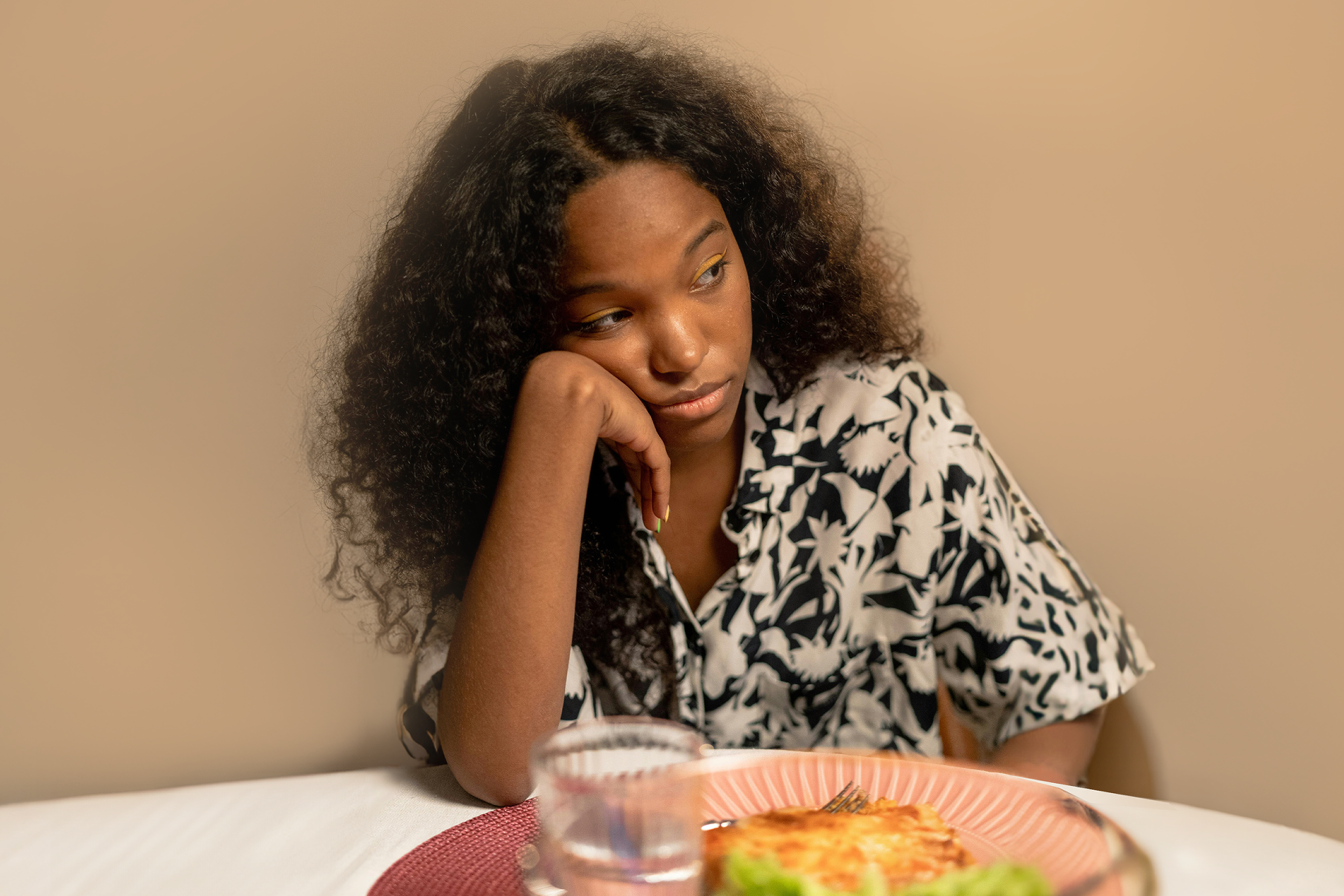

- Anorexia nervosa is a serious eating disorder characterized by restricted food intake and fear of weight gain.
- There are three subtypes of anorexia: anorexia restricting type (AN-R), anorexia binge-purge type (AN-BP), and atypical anorexia (AAN).
- Anorexia has significant consequences for mental and physical health, including osteoporosis, cardiovascular issues, immune dysfunction, hormonal imbalance, and more.
- Recovery from anorexia is possible. Treatment requires a multidisciplinary approach that includes a dietitian, therapist, and medical provider. Evidence-based treatment modalities include FBT, CBT-E, and DBT.

Anorexia nervosa is a complex eating disorder that can be challenging for patients, loved ones, and even healthcare providers to understand. It's not a choice or a phase—it's a serious, brain-based mental illness that can significantly harm someone's physical and mental health, and be life-threatening. And, despite common misconceptions, anorexia nervosa affects people of all body sizes, genders, ages, and backgrounds.
In general medicine, “anorexia" can also mean loss of appetite. This article covers the eating disorder anorexia nervosa, which is often referred to as simply “anorexia.” People with anorexia restrict their food intake and have an intense fear of weight gain and a distorted body image. Anorexia has two subtypes: restricting type, in which a person limits their food intake, and binge-purge type, in which a person not only restricts but also has episodes of binge eating and then purging through behaviors like vomiting or laxative use.
Learning about what is anorexia—including the causes, symptoms, health consequences, and treatment—can help you recognize when you or a loved one may need support, and take the first steps toward recovery.
What is anorexia nervosa?
Anorexia nervosa is an eating disorder characterized by restricted food intake and an intense fear of weight gain. “Someone with anorexia is not getting enough nourishment, and that impacts their brain in a way that makes it hard to make good judgments around food and their body. It also impacts their ability to understand the severity of the illness,” says licensed clinical psychologist Andrea Seefeldt, PsyD, CEDS.
The most recent Diagnostic and Statistical Manual of Mental Disorders (DSM-5) includes three criteria for anorexia:
- Restriction of caloric intake to the point where the person isn't getting the nutrients their body needs and they lose weight
- Intense fear of weight gain, or behaviors that prevent weight gain
- Body image disturbance or lack of recognition of the seriousness of their symptoms
Past editions of the DSM included amenorrhea—when someone stops getting their period for at least three months—as part of the criteria for anorexia nervosa. Per the DSM-5, a patient's menstrual status is no longer a factor to consider when diagnosing anorexia.
Types of anorexia
Although restricting what and how much someone eats is a key element of anorexia nervosa, people with this eating disorder may also engage in other behaviors and show other symptoms. When diagnosing patients, healthcare providers often identify one of the following subtypes of anorexia, depending on the dominant eating disorder symptoms someone is experiencing:
- Anorexia nervosa, restricting subtype (AN-R): The person restricts their food intake and does not engage in bingeing or purging. They may, however, exercise excessively.
- Anorexia nervosa, binge/purge subtype (AN-BP): In addition to restricting food, the person regularly binge eats (consuming a large amount of food in one sitting) and then purges (attempting to “get rid of the calories” with compensatory behaviors such as self-induced vomiting or the misuse of laxatives, diuretics, or enemas).
- Atypical AN (AAN): “Atypical anorexia,” which actually falls under the OSFED diagnosis, is a somewhat misleading label for someone with all of the symptoms of anorexia except for low weight. “Really, it's the same disorder with the exception of occurring in people who may start out in larger bodies and lose a significant amount of weight but their weight isn't considered dangerously low,” explains Barbara Kessel, DO, CEDS, a psychiatrist at Equip. She explains that those with atypical anorexia face the same health risks due to their behaviors, such as malnutrition.
There is a growing movement among eating disorder professionals to do away with the term “atypical anorexia” because it is so imprecise and misleading, and implies that AAN is less serious than other types of anorexia. Due to stigma and stereotypes, many healthcare providers fail to diagnose patients with AAN, who often don't enter treatment until later in their illness. Plus, so-called “atypical anorexia” is not atypical at all; in fact, most people with anorexia are not medically underweight.
Note that not everyone with anorexia fits neatly into one category or another; many eating disorder diagnoses can overlap, and someone may experience different symptoms at different times.
Causes and risk factors
It's difficult (if not impossible) to identify a specific cause for any type of eating disorder in any one person. However, research tells us that anorexia is a complex, neurobiological mental illness with a strong genetic component, and is influenced by social, environmental, and cultural factors, as well as one's temperament.
Here are some factors that place a person at a higher risk of developing anorexia:
- Having a parent or sibling with anorexia
- Experiencing teasing or bullying
- Perfectionistic tendencies
- Being more anxious or sensitive than most people
- Life stressors, such as moving, changing jobs, or losing a loved one
- Engaging in dieting or increased activity without properly refueling, which leads to an energy deficit (that is, they're burning more calories than they’re consuming)
Dieting—or striving for “healthy eating,” “clean eating,” or a “lifestyle change”—can be particularly risky. “Because we have such a diet-focused and weight-obsessed world, a parent, friend, or loved one might think, 'My child is just dieting' or 'Look, they're trying to be healthy, it's a good thing,'” Seefeldt says. But limiting or eliminating food groups in the name of “health” can quickly lead someone to take in an insufficient amount of calories. Even a shift to a plant-based diet for environmental or animal welfare reasons can result in an energy deficit that ultimately triggers an eating disorder. While anorexia is so much more than a “diet gone wrong,” dieting—by any name—is a significant risk factor for developing an eating disorder.
Intentional dietary changes aren't the only way someone can end up in an energy deficit. Illness, surgery, medication, or an increase in physical activity without sufficient refueling can all lead to someone unintentionally consuming insufficient calories.
It’s important to note that decades ago, experts often blamed parents—especially mothers—when a child developed anorexia. Although we now know that families are not to blame, this harmful belief persists in our culture, and can sometimes prevent people from seeking treatment.
Who does anorexia affect?
Anorexia nervosa doesn't discriminate. It can affect people of all ages, genders, body sizes, socioeconomic status, and races. Research shows that eating disorders equally affect females of all ethnicities; however, non-whites may be half as likely to receive treatment as whites. This is due to a variety of factors, including the fact that minorities may face stigma and limited access to care.
Although research suggests that women and girls are about 10 times more likely than men and boys to be diagnosed with anorexia nervosa, this number may not be accurate, as we don’t know how many males with anorexia go undiagnosed. Males with eating disorders face a double stigma—not only do they have a psychiatric disorder, they have a “female” disorder—and this can keep them from seeking treatment.
Signs and symptoms
Anorexia can be difficult to spot because the eating disorder usually doesn’t want to be seen. Many anorexia behaviors happen in secret, and the ones that happen publicly can sometimes go unnoticed, or even be perceived as being “healthy.” Rather than raise alarm bells, weight loss or showing “discipline” around food and exercise tend to garner praise. “Usually an eating disorder is going on for a while before anyone notices, and sometimes eating disorder behaviors are even praised,” Kessel says. “It may not be until weeks, months, or even years later that people realize that it’s problematic and has taken over the person's life and become more of a disorder than a healthy behavior.”
Knowing the symptoms of anorexia outlined below can help you stay informed and alert to concerning signs in yourself or someone you care about. Overall, if someone is unable to fully participate in life because of fears around food or not being able to exercise, or they’re being too rigid about those things, it's a red flag, Kessel says.
Food-related symptoms
Contrary to myths, having anorexia doesn’t mean not eating at all; most people with anorexia eat. Their behaviors or attitude around food, however, may indicate they are struggling. Here are some common warning signs:
- Studying nutrition labels (without a medical reason) and counting calories
- Turning down foods or food groups they previously enjoyed
- Using the bathroom (including taking showers) right after meals in order to purge (e.g., vomiting, exercising, or using laxatives)
- Cooking or baking for others, but not eating the food themselves
- Dining alone, and avoiding eating with family or friends
- Avoiding going out to eat or social events with food
- Engaging in food rituals, such as cutting food into tiny pieces, smearing food on the plate, needing to eat foods in a certain order, or adding an unusual amount of mustard, pickles, or other low-calorie condiments
- Refusing to drink anything but water or non-caloric beverages
- Saying they already ate or making other excuses for not eating
Physical signs
Because anorexia can affect every organ system in the body, it often comes with physical and physiological symptoms, including:
- Weight loss, or lack of expected weight gain or height growth in children
- Feeling cold all the time, even in warm environments
- Frequent illness or injuries (such as stress fractures)
- Loss of a period in those who would normally be menstruating
- Hair loss or growth of fine hair on the body (called lanugo)
- Dizziness or fainting
- Constipation, abdominal pain, or other GI issues
Exercise red flags
Many people with anorexia develop a disordered relationship with activity. Below are some warning signs that a person’s exercise behaviors may be related to an underlying eating disorder:
- Working out in a compulsive or secretive way
- Rigidly quantifying and tracking physical activity, such as with a fitness app
- Feeling compelled to complete an exact amount of exercise each day
- Never taking a day off—even if sick or injured—and feeling guilty if not able to exercise
- Exercising in order to “earn” or “burn off” food
- Obsessively emulating fitness influencers on social media
Concerns about appearance
Someone with anorexia often suffers from an unhealthy preoccupation with their body size. Common signs of serious body image problems include:
- Having a distorted perception of their body size
- Wearing oversized clothing
- Avoiding social activities because of appearance worries
- Weighing themselves frequently
- Engaging in body-checking behaviors, such as pinching their flesh, checking their appearances in mirrors, trying on specific clothing items to assess the fit, or measuring body parts, such as wrists, thighs, or waist
Changes in mood
When someone is malnourished from anorexia, it usually affects their mood and relationships, leading to:
- Symptoms of new or increased anxiety, depression, or obsessive-compulsive disorder
- Irritability
- Withdrawing from friends and family
- Losing their “sparkle”
- Intense perfectionism
- Rigid black-and-white thinking
- Struggling to name or express emotions
- Difficulty concentrating
How anorexia affects the body
The physical symptoms of anorexia only hint at what's going on at a deeper level inside the body. The malnutrition caused by anorexia can lead to body-wide issues, triggering a cascade of both short- and long-term health consequences.
- Cardiovascular effects: Inadequate nourishment can result in bradycardia (a slow heartbeat), hypotension (low blood pressure), and decreased heart rate variability (HRV, or a variation in the time between heartbeats). All of this increases the risk of sudden cardiac death.
- Endocrine effects: In women, underfueling your body can lead to functional hypothalamic amenorrhea (FHA), which is characterized by irregular or absent periods. This happens due to changes in levels of various hormones, including estrogen. FHA can lead to infertility and harm bone, heart, cognitive, and mental health.
- Skeletal effects: Estrogen promotes the growth of new bone cells and inhibits the breakdown of old bones. When estrogen levels decrease due to a restrictive diet, bone mass decreases. More than half of women who have anorexia also have osteopenia, or low bone density and weak bones, and about one-third have osteoporosis, which is more severe bone loss that makes you more susceptible to fractures and breaks.
- Neurocognitive effects: Imaging studies have shown that, in some patients, anorexia causes brain atrophy. This is more common in severe and chronic cases, and may cause challenges with decision-making and memory.
Anorexia treatment: What works and how to get help
Although anorexia is a serious illness that comes with various health risks, it's also treatable, and several types of evidence-based care exist for patients of all ages. There are different levels of care depending on how much support and supervision a patient needs.
For patients choosing in-person care, the treatment options (from most to least intensive) are:
Inpatient hospitalization: Patients who are medically and/or psychologically unstable need 24/7 care. Inpatient eating disorder treatment at a hospital allows medical providers to keep a close eye on the patient's vitals and to supervise and lend support during meals until they are stable. This stage of treatment tends to last a few weeks, then the patient steps down to a less-intense level of care.
Residential treatment: This is most often used by patients who are medically stable but continue to engage in eating disorder behaviors. Residential treatment provides 24-hour care and supervision in a home-like facility. In addition to medical care, patients often receive psychiatric care, therapy, nutritional counseling, and other support.
Partial hospitalization program (PHP): As the name implies, patients in PHP spend part of their time (often five to seven days a week for five to 10 hours a day) at their treatment center. This allows most, if not all, of their meals and snacks to be supervised. They also typically attend individual and group therapy and nutrition counseling sessions. However, they sleep at home.
Intensive outpatient program (IOP): Most patients in IOP need support reducing their eating disorder behaviors or thoughts. IOP programs offer individual and group therapy, nutrition counseling, and often family therapy and meal support. Patients typically come two to five days a week for about two to three hours at a time.
Low-touch outpatient care: The least intensive level of eating disorder care, outpatient treatment calls for medically stable patients to meet with their own individual providers on a regular basis. The majority of patients see a therapist and many also meet with a dietitian as well as a medical provider. This way someone is monitoring their vitals while they continue to receive support to stay on the path to recovery.
Another option is to pursue virtual treatment, which doesn’t neatly fit into the traditional level of care model. Virtual treatment is appropriate for all medically stable patients, and research shows that it’s just as effective as in-person care. It can also be more accessible, removing barriers to care and helping more people get treatment sooner. Plus, recovering in “real life”—as opposed to in a clinical setting—can offer additional benefits: patients practice coping skills and learn to manage triggers in their day-to-day life, with the support of their team, rather than not having to face these challenges until they’ve been discharged from treatment. Equip’s virtual model is built to adapt to the level of care each patient needs, with treatment becoming more or less intense depending on where a patient is on their recovery journey.

Tenets of effective care
Like treatment for any eating disorder, anorexia treatment should be personalized to the patient. Still, there are some fundamental elements that have been proven to make recovery more likely.
Multidisciplinary care team: Anorexia nervosa impacts every aspect of a patient's life. It makes sense, then, to find professionals who can support all of those aspects. A care team often includes a physician to monitor physical health, mental health professional to address the thoughts and behaviors, and a dietitian to provide nutritional counseling and support. Some patients also benefit from a psychiatrist, who can prescribe medication for co-occurring conditions like anxiety and depression. At Equip, patients also work with mentors who have lived experiencing recovering from an eating disorder.
Evidence-based modalities: Research shows that family-based treatment (FBT) is the gold standard for eating disorder treatment in children, adolescents, and young adults. For adults, several modalities may work. Enhanced cognitive behavior therapy (CBT-E), dialectical behavior therapy (DBT), and Maudsley model of anorexia nervosa treatment for adults (MANTRA), have the most evidence for this age group.
Weight restoration: Gaining weight is often, though not always, a critical part of anorexia treatment—and can be the hardest part. Like every other organ, the brain needs proper nutrition to function at its best—so weight restoration benefits a patient's ability to think clearly, process thoughts, and, in turn, do the work required in therapy. “Once the brain is better nourished, we can work on the cognitions and distorted thoughts,” Seefeldt says. Research shows that weight gain predicts psychological improvement and reduced eating disorder symptoms. Plus, patients who are discharged from treatment at higher weights have lower odds of relapse.
Body image work: Therapy can help patients who have distorted views of their bodies. They might work on stopping body checking, tolerating body changes during recovery, finding enjoyable ways to move their body, and practicing gratitude for what their body can do. This can be especially important given the prevalence of fatphobia in our society and how intensely critical people can be about others' bodies.
Medication: There's no FDA-approved medication that treats anorexia. However, some medications have been shown to help with weight restoration. “At the beginning of treatment, if a patient is very malnourished and underweight as compared to their target weight, we might use medication to help turn down the volume on the eating disorder cognitions and rigidity,” Kessel explains. “They don't do the work for you—you still have to show up and challenge the eating disorder—but they make it more doable.” Once someone is closer to their target weight, other medications may help treat comorbid disorders such as depression or obsessive compulsive disorder. “If we treat those comorbid conditions, folks are less likely to relapse,” Kessel says.
Relapse planning: Many patients write a relapse prevention plan as part of anorexia treatment. This document often outlines skills and strategies to manage triggers, signs of potential relapse, a plan for what to do if you start to slip up (including when to return to a treatment provider and who else to turn to for support), and motivation for recovery, such as a list of reasons to recover. These plans help patients stay on track toward recovery and ensure that, if they do take some steps back, a slip-up doesn’t snowball into a full-blown relapse.
When to get help
If you or your loved one is medically unstable due to anorexia, go to the emergency room.
Otherwise, if you’re at all concerned about yourself or a loved one, it’s important to reach out for help now, as early intervention is associated with better outcomes. Make an appointment to see a physician or mental health provider, or schedule a free, no-obligation consultation with an Equip team member. We offer tailored treatment plans according to your unique needs, goals, and challenges.
Whatever type of anorexia treatment you seek, don't delay. True healing and lasting recovery is within reach. “It's not an easy road, but with the right treatment, recovery is possible for anybody,” Kessel says. This is true even if you tried treatment in the past and it didn’t help, or you’ve relapsed. “It may be that you were in a different place back then or the treatment team wasn't right for you,” Kessel says. “There's always hope. The medical complications are almost all reversible, and you can feel better.”
FAQ
What’s the difference between “anorexia” and "anorexia nervosa”?
The definition of “anorexia” is “loss of appetite”. In fact, in general medicine, “anorexia” is considered a symptom. “Anorexia nervosa” is an eating disorder that's characterized by insufficient caloric intake and an intense fear of weight gain. However, the meaning of “anorexia” often depends on the context of your conversation. Many people refer to “anorexia nervosa” as simply “anorexia”.
Why do people with anorexia lose their period?
In short, people with anorexia lose their period and develop functional hypothalamic amenorrhea (FHA) because of insufficient nutrition. The long answer is that caloric restriction, excessive physical activity, and psychological stress combine to disrupt the hypothalamic-pituitary-ovarian (HPO) axis. This leads to reduced secretion of gonadotropin releasing hormone (GnRH) from the hypothalamus in the brain, which in turn leads to reduced production of luteinizing hormone (LH) and follicle-stimulating hormone (FSH). Without enough LH and FSH, the ovaries can't function properly, estrogen levels fall, and ovulation and menstruation don't occur.
What is lanugo and why does it happen?
Lanugo is fine, soft hair that grows all over a fetus's body. However, people with anorexia nervosa may also experience lanugo. In those instances, experts believe that lanugo is a sign of malnourishment and the body's attempt to conserve heat. Since weight loss often results in a loss of insulating fat, the downy hair acts in some ways like a blanket to keep the person warmer.
What are the two types of anorexia nervosa?
The two types of anorexia nervosa are restricting type and binge-purge type. People with restricting subtype severely limit their food intake and may engage in excessive exercise. In addition to restricting their food intake, people with binge-purge subtype also have episodes of binge eating and purging.
How is anorexia treated?
Anorexia treatment varies based on the severity of the eating disorder and often what resources the patient has access to. Generally speaking, some patients need hospitalization in order to become medically stable; then they can step down to less-intense levels of care. However, many patients can get better without ever leaving home, and virtual treatment can be just as effective as in-person treatment. In terms of types of therapy, family-based treatment (FBT) is the gold-standard treatment for anorexia in children, adolescents, and young adults. For adults, first-line therapies include cognitive behavioural therapy for eating disorders (CBT-E), dialectical behavior therapy (DBT), and Maudsley Anorexia Nervosa Treatment for Adults (MANTRA).
Is anorexia a choice?
“Nobody chooses to have anorexia, and it's no one's fault,” Seefeldt says. Anorexia is a serious brain-based mental illness that affects a person's mental and physical health and can even be life-threatening. That's why it's essential to seek professional help. Treatment, which often includes psychotherapy, nutritional counseling, medical monitoring, and sometimes medication, can help patients achieve lasting recovery.
- Moore, Christine A. and Bokor, Brooke R. “Anorexia Nervosa.” Stat Pearls. StatPearls Publishing (2025).https://www.ncbi.nlm.nih.gov/books/NBK459148/
- “DSM-5 Changes: Implications for Child Serious Emotional Disturbance [Internet].” Substance Abuse and Mental Health Services Administration (2016). https://www.ncbi.nlm.nih.gov/books/NBK519712/table/ch3.t15/
- “DSM-5-TR® Update Supplement to Diagnostic and Statistical Manual of Mental Disorders, Fifth Edition, Text Revision.” American Psychiatric Association (2024). https://www.psychiatry.org/getmedia/2ed086b0-ec88-42ec-aa0e-f442e4af74e6/APA-DSM5TR-Update-September-2024.pd
- Vo, Megen and Golden, Neville. “Medical complications and management of atypical anorexia nervosa.” Journal of Eating Disorders vol. 10 (2022):196. doi:10.1186/s40337-022-00720-9
- Nagy, Hassan, et al. “A Clinical Overview of Anorexia Nervosa and Overcoming Treatment Resistance.” Avicenna Journal of Medicine vol. 13,1 (2022):3–14. doi:10.1055/s-0042-1758859
- Cheng, Zhen Hadassah, et al. "Ethnic differences in eating disorder prevalence, risk factors, and predictive effects of risk factors among young women." Eating Behaviors vol. 32 (2018):23–30. doi:10.1016/j.eatbeh.2018.11.004
- Moreno, Ruby, et al. “Disparities in access to eating disorders treatment for publicly-insured youth and youth of color: a retrospective cohort study.” Journal of Eating Disorders vol.11 (2023):10. doi:10.1186/s40337-022-00730-7
- Van Eeden, Annelies E, et al. "Incidence, prevalence and mortality of anorexia nervosa and bulimia nervosa." Current Opinion in Psychiatry vol. 34,6 (2021):515–524. doi:10.1097/YCO.0000000000000739
- "Co-Occurring Diagnoses and Conditions." National Eating Disorders Association (n.d.). https://www.nationaleatingdisorders.org/co-occurring-diagnoses-and-conditions/
- Puckett, Leah, et al. “A Comprehensive Review of Complications and New Findings Associated with Anorexia Nervosa.” Journal of Clinical Medicine vol. 10,12 (2021):2555. doi:10.3390/jcm10122555
- Springall, Gabriella A C, et al. “Long-term cardiovascular consequences of adolescent anorexia nervosa.” Pediatric Research vol. 94,4 (2023):1457–1464. doi:10.1038/s41390-023-02521-5
- Saadedine, Mariam, et al. "Functional Hypothalamic Amenorrhea: Recognition and Management of a Challenging Diagnosis." Mayo Clinic Proceedings vol. 98, 9 (2023):1376-1385. doi:10.1016/j.mayocp.2023.05.027
- Fazeli, Pouneh K. "Low bone mineral density in anorexia nervosa: Treatments and challenges." Clinical Reviews in Bone and Mineral Metabolism vol. 17,2 (2019):65–76. doi:10.1007/s12018-019-09260-4
- Broomfield, Catherine, et al. “The Neuropsychological Profile of Severe and Enduring Anorexia Nervosa: A Systematic Review.” Frontiers in Psychology vol. 12 (2021):708536. doi:10.3389/fpsyg.2021.708536
- Tenconi, Elena, et al. “Clinical and Cognitive Functioning Changes After Partial Hospitalization in Patients With Anorexia Nervosa.” Frontiers in Psychology vol.12 (2021):653506. doi:10.3389/fpsyt.2021.653506
- Blalock, Dan V, et al. “Virtual Versus In-Person Intensive Outpatient Treatment for Eating Disorders During the COVID-19 Pandemic in United States–Based Treatment Facilities: Naturalistic Study.” Journal of Medical Internet Research vol. 27 (2025):e66465. doi:10.2196/66465
- Thaler, Lea, et al. “Outcomes of a Virtual Day Treatment Program for Adults With Eating Disorders-Comparison With In-Person Day Treatment.” International Journal of Eating Disorders vol. 57,10 (2024):2135-2140. doi:10.1002/eat.24263
- Fernández García, Sheila and Quiles Marcos, Yolanda. "Effectiveness of the Maudsley Model of Anorexia Nervosa Treatment for Adults: A systematic review." European Eating Disorders Review vol. 32,6 (2024):1227-1241. doi:10.1002/erv.3122
- Accurso, Erin C, et al. “Is weight gain really a catalyst for broader recovery?: The impact of weight gain on psychological symptoms in the treatment of adolescent anorexia nervosa.” Behaviour Research and Therapy vol. 56 (2014):1–6. doi:10.1016/j.brat.2014.02.006
- Frostad, Stein, et al. "BMI at Discharge from Treatment Predicts Relapse in Anorexia Nervosa: A Systematic Scoping Review.” Journal of Personalized Medicine vol. 12,5 (2022):836. doi:10.3390/jpm12050836







